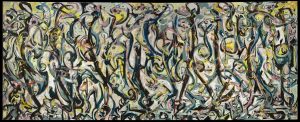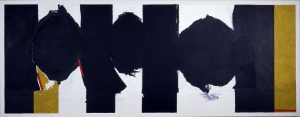Nelson-Atkins
July 8 - Oct. 29, 2017
Two famed American artists are featured in the focus exhibition Pollock and Motherwell: Legends of Abstract Expressionism, which opens at The Nelson-Atkins Museum of Art in Kansas City July 8. The exhibition includes two monumental paintings, Jackson Pollock’s Mural and Robert Motherwell’s Elegy to the Spanish Republic, No. 126. Pollock’s work is freewheeling and frenzied while Motherwell’s painting presents a rhythmic, consistent structure.“Jackson Pollock and Robert Motherwell were vital figures of mid-20th-century American painting,” said Julián Zugazagoitia, Menefee D. and Mary Louise Blackwell CEO & Director of the Nelson-Atkins. “Both innovated new approaches to creative expression. They also shared colorful, intense personalities that raised their profiles not just in the art world but in the public imagination.”

Jackson Pollock, Mural, 1943. Oil and casein on canvas, 95 5/8 x 237 3/4 inches. Gift of Peggy Guggenheim, 1959.6. University of Iowa Museum of Art, Iowa City. Reproduced with permission from The University of Iowa Museum of Art. Photograph courtesy the J. Paul Getty Museum, Los Angeles, 2014.
Mural, Pollock’s largest-ever canvas, was commissioned in 1943 by famed art collector and dealer Peggy Guggenheim for her New York City apartment and helped launch him to international acclaim. Mural is a complex fusion of brushstrokes and splatters. An array of vivid colors weaves across the canvas while calligraphic forms of dark brown divide the repetitive composition. Pollock later recalled that the painting’s imagery is that of a Western stampede. Other scholars claim totemic figures march across the surface. Mural marked a turning point for Pollock, with its vigorous abstraction, massive scale, and bold freedom. In 1948 Guggenheim gifted the painting to the University of Iowa. It underwent a two-year conservation effort by The Getty Research Institute in Los Angeles beginning in 2012.

Robert Motherwell, Elegy to the Spanish Republic, No. 126, 1965-75. Acrylic on canvas, 77 3/4 x 200 1/4 inches. Purchased with the aid of funds from The National Endowment for the Arts with matching funds and partial gift of Robert Motherwell. University of Iowa Museum of Art, Iowa City. © Dedalus Foundation, Inc. Licensed by VAGA, New York, NY.
Motherwell’s Elegy to the Spanish Republic, No. 126 is among the most elegant works of his career due to its vastness and thoughtful integration of color. The painting is a unique salute to Pollock. In 1972, the director of the University of Iowa Museum of Art commissioned the painting to hang with and visually respond to Mural’s monumental size. While many interpretations exist, Elegy’s theme explores the challenges and tensions of modern life. Ovals confined between vertical elements may symbolize remembrances of life and death. The composition is full of contrasts–straight and curved forms, black and white paint, brushy and pooled pigment. The title laments the war-torn demise of the Spanish Republic and the following conflict of World War II.
In an era of celebrity, Pollock and Motherwell fashioned memorable personas to elevate their status in the art world and popular culture. Investigations by art historians and conservators have since revealed new insights into the artists’ lives, their paintings, and the Abstract Expressionist movement.
“This exhibition will present a unique opportunity to consider the idea of legendary stories,” said Sherèe Lutz, the curator of this installation. “Ranging from conservation histories to inventive narratives surrounding the artists, we pull back the curtain to reveal some behind-the-scenes information about the paintings, the artists, and the movement.”
Abstract Expressionism was never a formalized art movement but instead was characterized by individualism, freedom, and a break from tradition in technique and subject. Centered in New York City in the 1940s and 1950s, artists embraced emotion and non-representational forms. They shared a mixture of ideas including interest in existential philosophy, Jungian psychology, the romantic sublime, and art from around the globe.
Jackson Pollock (1912-1956) was born in Cody, Wyoming, the youngest of five boys. After growing up in Arizona and California, Pollock moved to New York City in 1930 to study painting at the Art Students’ League with Thomas Hart Benton. He later worked on the Federal Art Project during the Depression. Ultimately, he became internationally famous for his experimental dripped and poured paintings. Pollock’s struggle with alcoholism tragically led to an early death in a car accident.
Robert Motherwell (1915-1991) grew up in California in an affluent, although unhappy, family. He enjoyed an elite education that included studying poetry, philosophy, and art history. Eventually, he shifted his focus to fine arts after seeing modern French painting in Paris. Motherwell cited a trip to Mexico with friend and fellow artist Roberto Matta as a major influence on his body of work, especially on the content in his Elegy series. In addition to working in painting, printmaking, and collage, Motherwell was a leading art theorist. He taught at universities in New York and North Carolina.
Comments
Post a Comment